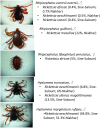Tick-borne rickettsioses, neglected emerging diseases in rural Senegal
- PMID: 20856858
- PMCID: PMC2939048
- DOI: 10.1371/journal.pntd.0000821
Tick-borne rickettsioses, neglected emerging diseases in rural Senegal
Expression of concern in
-
Expression of Concern: Tick-Borne Rickettsioses, Neglected Emerging Diseases in Rural Senegal.PLoS Negl Trop Dis. 2022 Dec 13;16(12):e0010956. doi: 10.1371/journal.pntd.0010956. eCollection 2022 Dec. PLoS Negl Trop Dis. 2022. PMID: 36512527 Free PMC article. No abstract available.
Abstract
Background: Rickettsioses are one of the most important causes of systemic febrile illness among travelers from developed countries, but little is known about their incidence in indigenous populations, especially in West Africa.
Methodology/principal findings: Overall seroprevalence evaluated by immunofluorescence using six rickettsial antigens (spotted fever and typhus group) in rural populations of two villages of the Sine-Saloum region of Senegal was found to be 21.4% and 51% for spotted fever group rickettsiae for Dielmo and Ndiop villages, respectively. We investigated the role of tick-borne rickettsiae as the cause of acute non-malarial febrile diseases in the same villages. The incidence of rickettsial DNA in 204 blood samples from 134 (62M and 72F) febrile patients negative for malaria was studied. DNA extracted from whole blood was tested by two qPCR systems. Rickettsial DNA was found in nine patients, eight with Rickettsia felis (separately reported). For the first time in West Africa, Rickettsia conorii was diagnosed in one patient. We also tested 2,767 Ixodid ticks collected in two regions of Senegal (Niakhar and Sine-Saloum) from domestic animals (cows, sheep, goats, donkeys and horses) by qPCR and identified five different pathogenic rickettsiae. We found the following: Rickettsia aeschlimannii in Hyalomma marginatum rufipes (51.3% and 44.8% in Niakhar and Sine-Saloum region, respectively), in Hyalomma truncatum (6% and 6.8%) and in Rhipicephalus evertsi evertsi (0.5%, only in Niakhar); R. c. conorii in Rh. e. evertsi (0.4%, only in Sine-Saloum); Rickettsia massiliae in Rhipicephalus guilhoni (22.4%, only in Niakhar); Rickettsia sibirica mongolitimonae in Hyalomma truncatum (13.5%, only in Sine-Saloum); and Rickettsia africae in Rhipicephalus evertsi evertsi (0.7% and 0.4% in Niakhar and Sine-Saloum region, respectively) as well as in Rhipicephalus annulatus (20%, only in Sine-Saloum). We isolated two rickettsial strains from H. truncatum: R. s. mongolitimonae and R. aeschlimannii.
Conclusions/significance: We believe that together with our previous data on the high prevalence of R. africae in Amblyomma ticks and R. felis infection in patients, the presented results on the distribution of pathogenic rickettsiae in ticks and the first R. conorii case in West Africa show that the rural population of Senegal is at risk for other tick-borne rickettsioses, which are significant causes of febrile disease in this area.
Conflict of interest statement
The authors have declared that no competing interests exist.
Figures




Similar articles
-
Identification of rickettsial pathogens in ixodid ticks in northern Senegal.Ticks Tick Borne Dis. 2014 Sep;5(5):552-6. doi: 10.1016/j.ttbdis.2014.04.002. Epub 2014 Jun 4. Ticks Tick Borne Dis. 2014. PMID: 24908548
-
High prevalence of Rickettsia africae variants in Amblyomma variegatum ticks from domestic mammals in rural western Kenya: implications for human health.Vector Borne Zoonotic Dis. 2014 Oct;14(10):693-702. doi: 10.1089/vbz.2014.1578. Vector Borne Zoonotic Dis. 2014. PMID: 25325312 Free PMC article.
-
Molecular detection of spotted fever group rickettsiae in ticks from Cameroon.Ticks Tick Borne Dis. 2018 May;9(4):1049-1056. doi: 10.1016/j.ttbdis.2018.03.022. Epub 2018 Mar 29. Ticks Tick Borne Dis. 2018. PMID: 29636236
-
Tick-borne rickettsioses in Europe.Ticks Tick Borne Dis. 2012 Dec;3(5-6):271-8. doi: 10.1016/j.ttbdis.2012.10.035. Epub 2012 Nov 21. Ticks Tick Borne Dis. 2012. PMID: 23177355 Review.
-
Spotted fever rickettsioses in southern and eastern Europe.FEMS Immunol Med Microbiol. 2007 Feb;49(1):2-12. doi: 10.1111/j.1574-695X.2006.00138.x. FEMS Immunol Med Microbiol. 2007. PMID: 17266709 Review.
Cited by
-
Tick-borne infections in human and animal population worldwide.Vet World. 2015 Mar;8(3):301-15. doi: 10.14202/vetworld.2015.301-315. Epub 2015 Mar 12. Vet World. 2015. PMID: 27047089 Free PMC article. Review.
-
Knowledge, attitudes and practices on African tick bite fever of rural livestock communities living in a livestock-wildlife interface area in the Eastern Cape Province of South Africa.BMC Infect Dis. 2021 May 28;21(1):497. doi: 10.1186/s12879-021-06174-9. BMC Infect Dis. 2021. PMID: 34049499 Free PMC article.
-
Molecular detection and characterization of tick-borne pathogens in dogs and ticks from Nigeria.PLoS Negl Trop Dis. 2013;7(3):e2108. doi: 10.1371/journal.pntd.0002108. Epub 2013 Mar 7. PLoS Negl Trop Dis. 2013. PMID: 23505591 Free PMC article.
-
Aetiologies of bacterial tick-borne febrile illnesses in humans in Africa: diagnostic limitations and the need for improvement.Front Med (Lausanne). 2024 Sep 16;11:1419575. doi: 10.3389/fmed.2024.1419575. eCollection 2024. Front Med (Lausanne). 2024. PMID: 39351006 Free PMC article. Review.
-
Molecular survey of cattle ticks in Burundi: First report on the presence of the invasive Rhipicephalus microplus tick.PLoS One. 2021 Dec 10;16(12):e0261218. doi: 10.1371/journal.pone.0261218. eCollection 2021. PLoS One. 2021. PMID: 34890445 Free PMC article.
References
-
- Conor A, Bruch A. Une fièvre eruptive observée en Tunisie. Bull Soc Pathol Exot Filial. 1910;8:492–496.
-
- McNaught JG. A tick-bite in the Union of South Africa. J R Army Med Corps. 1911;16:505.
-
- Sant'Anna JF. On a disease in man following tick-bites and occurring in Lourenco Marques. Parasitology. 1912;4:87–88.
-
- Pijper A. Etude expérimentale comparée de la Fièvre boutonneuse et de la Tick-Bite-Fever. Arch Inst Pasteur Tunis. 1936;25:388–401.
-
- Gear JHS. South African typhus. S Afr J Med Sci. 1938;3:134–160.
MeSH terms
Substances
LinkOut - more resources
Full Text Sources
Medical
Molecular Biology Databases

